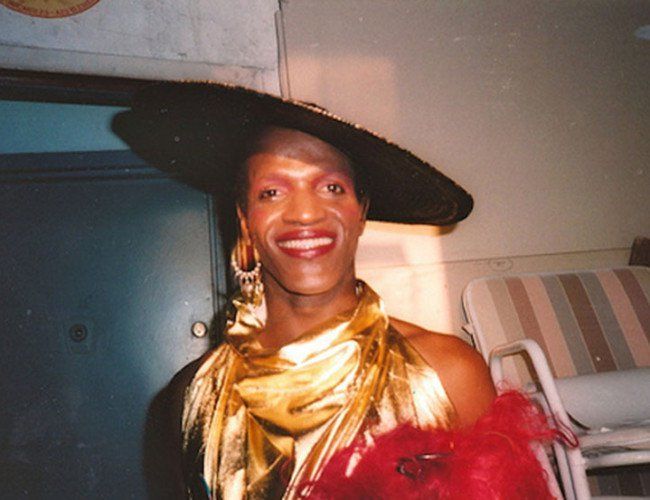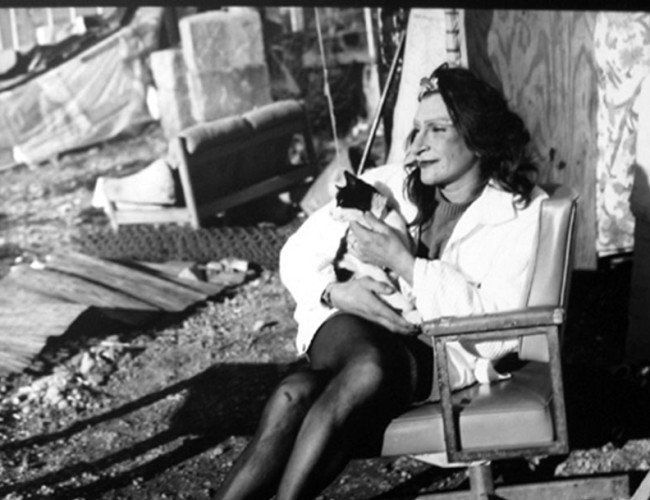I began my transition in 1992. Part of what came with that was the meed for a hair stylist. I found mine at the Pink House in Conway, Arkansas. It was owned by John Schenck and Robert Lloyd, Their story is here at Freedom to Marry.
 John used to tell me stories from the old days. He was well positioned to do so since he worked as a bar back (i.e. bartending assistant) at the Stonewall back in the day. He told me about the night of June 28, 1969, when the police raided (not such a common occurrence at the Stonewall since there were payoffs) and especially began to hassle a Puerto Rican drag queen John only knew as José.
John used to tell me stories from the old days. He was well positioned to do so since he worked as a bar back (i.e. bartending assistant) at the Stonewall back in the day. He told me about the night of June 28, 1969, when the police raided (not such a common occurrence at the Stonewall since there were payoffs) and especially began to hassle a Puerto Rican drag queen John only knew as José.
On that night there was a private party going on at the Stonewall. Regular patron Marsha P. (Pay it No Mind) Johnson was turning 25. Guests included other drag queens and some “girls who were serious” (in John’s terminology; he means “transgender women”) Some of the transwomen also did drag in order to make a buck…like Ms. Johnson.
During the riots, Marsha was observed dropping a heavy weight onto a police car – a powerful moment in the initial resistance.
Following the protests, Marsha took a pioneering role in the movement. She demonstrated on Wall Street in the 1980s against the extreme prices of AIDS drugs and was a mother figure to many LGBTI youths to come her way. She died in 1992 at 48 under mysterious circumstances, with her body found floating in the Hudson River. The case remains unsolved.
 Stormé Delarverie was there. A drag king, singer, bouncer and bodyguard, she was rumored to have thrown the first punch. Delarverie was a woman of mixed racial background fom New Orleans.
Stormé Delarverie was there. A drag king, singer, bouncer and bodyguard, she was rumored to have thrown the first punch. Delarverie was a woman of mixed racial background fom New Orleans.
She worked for much of her life as an MC, singer, bouncer, bodyguard and volunteer street patrol worker, the “guardian of lesbians in the Village.
She is known as “the Rosa Parks of the gay community.”
It is unknown whether Stormé was the one woman who fought her way out of a police wagon, but all accounts agree that she was one of several butch lesbians who fought back against the police.
Tammy Novak was an 18-year-old transgender woman who is also known to be one of the first people to fight back.
She had lived with mob owner Fat Tony so was one of the few allowed to enter the bar in full women’s clothing. The bar was mostly made of a third white, third black and a third Hispanic with only a few trans women and drag queens allowed in, according to David Carter’s Stonewall biography.
Arrested and put in the paddy wagon for drag queens, Tammy escaped during the confusion.
Tammy has been reported to be one of the first throw some punches. Tammy disappeared from history some time in 1969.
 Tammy coerced her friend Sylvia Rivera into attending the party. She reportedly arrived just after the fighting began and is believed to have yelled, ‘It’s the revolution!’ and to have been one of the first people to have thrown a bottle. Whatever is the exact truth, it is known that the hundreds of inhabitants of the park across the street, who were too poor to afford the bar’s entrance fee, rushed the place. They were young, homeless and destitute…but they became a community on that night.
Tammy coerced her friend Sylvia Rivera into attending the party. She reportedly arrived just after the fighting began and is believed to have yelled, ‘It’s the revolution!’ and to have been one of the first people to have thrown a bottle. Whatever is the exact truth, it is known that the hundreds of inhabitants of the park across the street, who were too poor to afford the bar’s entrance fee, rushed the place. They were young, homeless and destitute…but they became a community on that night.
Sylvia was a founding member of both the Gay Liberation Front and Gay Activists Alliance, as well as co-founding the Street Transvestite Action Revolutionaries with her close friend Marsha P. Johnson. She dedicated her life to helping homeless young drag queens and trans women.
[Before Stonewall] we never realized how connected we were as a community.
It didn’t make a difference if you were a drag queen, or if you were a leather queen, or if you were just a young kid, or if you were an older person over 30, we were all fighting for a right… to get back into the bar, to be able to dance, not be oppressed.
Erasure started directly after the riots. Some came from outside sources, like New York Times reporters, who didn’t understand or prioritize complexities of identity and just called everyone “men” in articles that are now primary sources. Some came from within the LGBT community, which, dusting itself off and finding that it suddenly was a community, suffered from infighting – RadFems and Lesbian Liberation Movement members fought with trans* women; there were brawls for the mic at pride parades. Later, when the first LGBT historians were compiling what would become the first official narratives, some, like Wayne Dynes, confused a lack of static terminology (there have been many words for “trans*” over the years) for a lack of existence (others did the same with a lack of photographs).
–Cara, Autostradle
So now we have a new rewriting of history, full of, a some people have called it, white-washing and cisplaining. This movie is due to be released September 25.
The eponymous riots, which took place July 28, 1969, were kickstarted by people of color, hustlers, lesbians, drag queens, and transgender people after a police raid on the Greenwich Village bar. That’s apparently been transformed into a tale in which a young, hot, white cutie from a Middle American home with a Middle American porch comes to the big city with his bee-stung lips and form-fitting white T-shirts.
Soon he is leading the revolution in full Les Miz mode, as another hot guy who’s a quiet campaigning politico tries to caution him that sensible, safe protest is the way forward. (Put the rock down, son!)
–Tim Teeman, The Daily Beast
Director Roland Emmerich has been driven to post response to the criticism.
When I first learned about the Stonewall Riots through my work with the Los Angeles Gay and Lesbian Center, I was struck that the circumstances that lead to LGBT youth homelessness today are pretty much the same as they were 45 years ago. The courageous actions of everyone who fought against injustice in 1969 inspired me to tell a compelling, fictionalized drama of those days centering on homeless LGBT youth, specifically a young midwestern gay man who is kicked out of his home for his sexuality and comes to New York, befriending the people who are actively involved in the events leading up to the riots and the riots themselves. I understand that following the release of our trailer there have been initial concerns about how this character’s involvement is portrayed, but when this film – which is truly a labor of love for me – finally comes to theaters, audiences will see that it deeply honors the real-life activists who were there – including Marsha P. Johnson, Sylvia Rivera, and Ray Castro – and all the brave people who sparked the civil rights movement which continues to this day. We are all the same in our struggle for acceptance.
Here’s Sylvia:
Still today we find transgender people referred to as a bunch of Janey- and Johnny-come-lately’s who don’t really belong trying to ride the meaningful work done by gays and lesbians in the fight for the freedom to be who we are…and we should just calm down and accept that we should wait for another quarter of a century or so for “our turn” at the equality faucet.
This movie may help our cause…but this trailer doesn’t convince anyone of that. So we have the calls to boycott, which I wouldn’t count on ending anytime soon. Emmerich could have done everyone, including himself, a huge favor if he would have at least cast transgender actors to play the roles of the transgender women.
But that was not his goal. Emmerich himself says, “We are all the same in our struggle for acceptance.” Many transgender people have yet to see any fruit from that tree.

1 comments
Author
…and difficult to really understand from the outside. Can’t tell the players without a scorecard. My intention was to outline a scorecard.